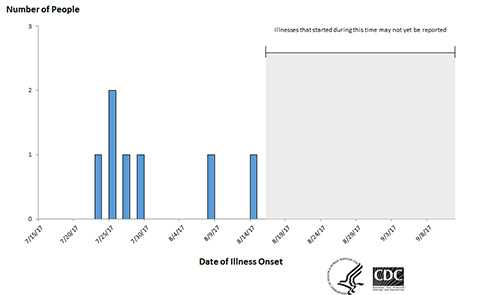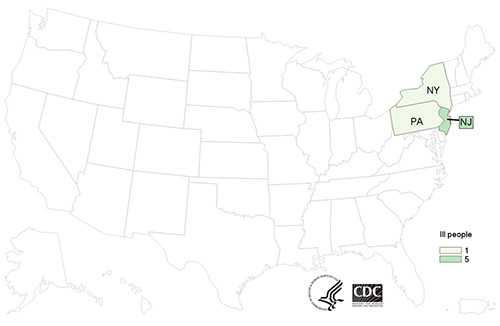Multistate Outbreak of Salmonella Urbana Infections Linked to Imported Maradol Papayas
Posted September 14, 2017 3:45 PM ET
This outbreak is one of four separate outbreaks currently under investigation that are linked to imported Maradol papayas from Mexico. For information on the other outbreaks, please visit the Active Salmonella Outbreaks webpage.
Highlights
- Read the Advice to Consumers, Restaurants, and Retailers >>
- This outbreak is one of four separate outbreaks currently under investigation that are linked to imported Maradol papayas from Mexico. Each outbreak is linked to papayas imported from a different farm in Mexico.
- CDC, public health and regulatory officials in several states, and the U.S. Food and Drug Administration (FDA) are investigating a multistate outbreak of Salmonella infections.
- The same strain of Salmonella was found in samples collected from papayas and from ill people.
- Seven people infected with the outbreak strain of Salmonella Urbana have been reported from 3 states.
- Illnesses started on dates ranging from July 23, 2017 to August 14, 2017.
- Four people have been hospitalized. No deaths have been reported.
- Epidemiologic and laboratory evidence indicates that Maradol papayas from the El Zapotanito farm in La Huerta, Mexico are the likely source of this multistate outbreak.
- CDC recommends that consumers not eat, restaurants not serve, and retailers not sell Maradol papayas from the El Zapotanito farm in Mexico.
- If you aren’t sure if the papaya you bought is a Maradol papaya from El Zapotanito farm, ask the place of purchase. Restaurants and retailers can ask their suppliers.
- When in doubt, don’t eat, sell, or serve papayas; just throw them out.
- Wash and sanitize countertops as well as drawers or shelves in refrigerators where Maradol papayas were stored.
- Because four separate outbreaks linked to papayas from different farms have been identified, CDC is concerned that papayas from other farms in Mexico might be contaminated with Salmonella and have made people sick.
- FDA continues testing papayas from Mexico to see if other papayas from other farms are contaminated with Salmonella. Investigations are ongoing to determine if additional consumer warnings are needed beyond the advice not to eat papayas from the specific farm given in this update, and from specific farms given in web postings about the other Salmonella outbreaks linked to Maradol papayas. CDC will provide updates when more information is available.
Initial Announcement
Introduction
This outbreak is one of four separate outbreaks currently under investigation that are linked to imported Maradol papayas from Mexico.
CDC, public health and regulatory officials in several states, and the U.S. Food and Drug Administration (FDA) are investigating a multistate outbreak of Salmonella Urbana infections.
Public health investigators are using the PulseNet system to identify illnesses that may be part of this outbreak. PulseNet is the national subtyping network of public health and food regulatory agency laboratories coordinated by CDC. DNA fingerprinting is performed on Salmonella bacteria isolated from ill people by using techniques called pulsed-field gel electrophoresis (PFGE) and whole genome sequencing (WGS). CDC PulseNet manages a national database of these DNA fingerprints to identify possible outbreaks. WGS gives a more detailed DNA fingerprint than PFGE.
Investigation of the Outbreak
Since the last update on September 1, 2017, one more ill person from one state was added to this investigation.
As of September 11, 2017, seven people infected with the outbreak strain of Salmonella Urbana have been reported from three states. A list of the states and the number of cases in each can be found on the Case Count Map page.
Illnesses started on dates ranging from July 23, 2017 to August 14, 2017. Ill people range in age from less than 1 year to 57, with a median age of 1. Four (57%) are female. Among 6 people, 5 (83%) are of Hispanic ethnicity. Among 6 people with available information, 4 (67%) have been hospitalized. No deaths have been reported.
In interviews, ill people answered questions about the foods they ate and other exposures in the week before they became ill. Three (75%) of four people interviewed reported eating papayas. This proportion was significantly higher than results from a survey [PDF – 29 pages] of healthy Hispanic people in which 22% reported eating papayas in the week before they were interviewed during the summer months.
This outbreak can be illustrated with a chart showing the number of people who became ill each day. This chart is called an epidemic curve or epi curve. Illnesses that occurred after August 15, 2017, might not be reported yet due to the time it takes between when a person becomes ill and when the illness is reported. This takes an average of 2 to 4 weeks. Please see the Timeline for Reporting Cases of Salmonella Infection for more details.
As a result of this summer’s outbreak investigation linked to papayas, FDA has increased testing of papayas from Mexico to see if papayas from other farms are contaminated with Salmonella. Through this increased testing, FDA identified Salmonella Urbana on papayas from El Zapotanito in La Huerta, Mexico. Investigators compared PFGE and WGS results of Salmonella isolates from the papayas to isolates from ill people in the CDC PulseNet database. These results showed the Salmonella Urbana papaya isolate shared the same DNA fingerprint as the Salmonella Urbana isolates from ill people. This result provides more evidence that people in this outbreak got sick from eating contaminated Maradol papayas.
FDA reports that the shipment of papayas found to be contaminated was destroyed and was not distributed for sale in the United States. Papayas from El Zapotanito farm were distributed in the United States earlier this year, but FDA reports that no shipments of papayas from the farm are on the market in the United States because they are past their shelf life.
Because four separate outbreaks linked to papayas from different farms have been identified, CDC is concerned that papayas from other farms in Mexico might be contaminated with Salmonella and have made people sick. FDA continues testing papayas from Mexico to see if papayas from other farms are contaminated with Salmonella.
Investigations are ongoing to determine if additional consumer warnings are needed beyond the advice not to eat papayas from the specific farm given in this update, and from specific farms given in web postings about the other Salmonella outbreaks linked to Maradol papayas. CDC will provide updates when more information is available.
- Page last reviewed: September 14, 2017
- Page last updated: September 15, 2017
- Content source:


 ShareCompartir
ShareCompartir


